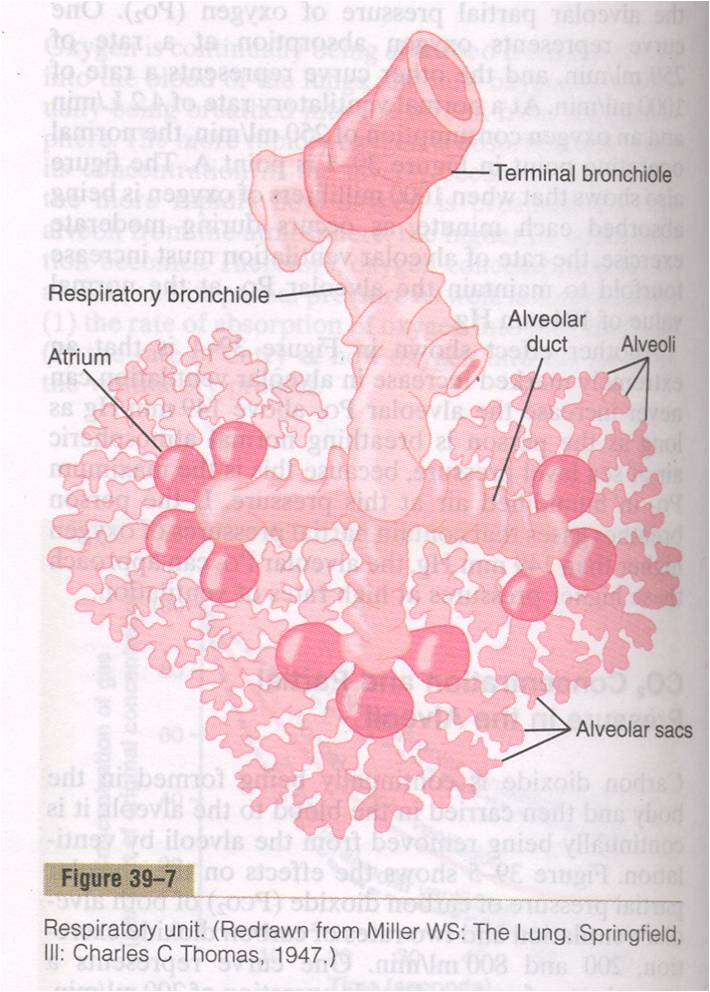
WEEK 1-5:Pulmanory Ventilation
The lungs can be expanded and contracted in two ways: (1) by downward and
upward movement of the diaphragm to lengthen or shorten the chest cavity,
and (2) by elevation and depression of the ribs to increase and decrease the
anteroposterior diameter of the chest cavity.Normal quiet breathing is accomplished almost entirely by the first method,
that is, by movement of the diaphragm. During inspiration, contraction of the
diaphragm pulls the lower surfaces of the lungs downward. Then, during expiration,
the diaphragm simply relaxes, and the elastic recoil of the lungs, chest
wall, and abdominal structures compresses the lungs and expels the air. During
heavy breathing, however, the elastic forces are not powerful enough to cause
the necessary rapid expiration, so that extra force is achieved mainly by contraction
of the abdominal muscles, which pushes the abdominal contents
upward against the bottom of the diaphragm, thereby compressing the lungs.The most important muscles that raise the rib cage are the external
intercostals, but others that help are the (1) sternocleidomastoid muscles,
which lift upward on the sternum; (2) anterior serrati, which lift many of the
ribs; and (3) scaleni, which lift the first two ribs.
The muscles that pull the rib cage downward during expiration are mainly
the (1) abdominal recti, which have the powerful effect of pulling downward on
the lower ribs at the same time that they and other abdominal muscles also compress
the abdominal contents upward against the diaphragm, and (2) internal
intercostals.The extent to which the lungs will expand for each unit
increase in transpulmonary pressure (if enough time is
allowed to reach equilibrium) is called the lung compliance.
The total compliance of both lungs together in
the normal adult human being averages about 200 milliliters
of air per centimeter of water transpulmonary
pressure. That is, every time the transpulmonary pressure
increases 1 centimeter of water, the lung volume,
after 10 to 20 seconds, will expand 200 millilitersSurfactant is a
surface active agent in water, which means that it
greatly reduces the surface tension of water. It is
secreted by special surfactant-secreting epithelial cells
called type II alveolar epithelial cells, which constitute
about 10 per cent of the surface area of the alveoli.
These cells are granular, containing lipid inclusions
that are secreted in the surfactant into the alveoli.
Surfactant is a complex mixture of several
phospholipids, proteins, and ions. The most important
components are the phospholipid dipalmitoylphosphatidylcholine,
surfactant apoproteins, and calcium
ions. The dipalmitoylphosphatidylcholine, along with
several less important phospholipids, is responsible
for reducing the surface tension. It does this by not
dissolving uniformly in the fluid lining the alveolar
surface. Instead, part of the molecule dissolves,
while the remainder spreads over the surface of the
water in the alveoli. This surface has from one
twelfth to one half the surface tension of a pure water
surface.
In quantitative terms, the surface tension of different
water fluids is approximately the following: pure
water, 72 dynes/cm; normal fluids lining the alveoli but
without surfactant, 50 dynes/cm; normal fluids lining
the alveoli and with normal amounts of surfactantincluded, between 5 and 30 dynes/cm.


